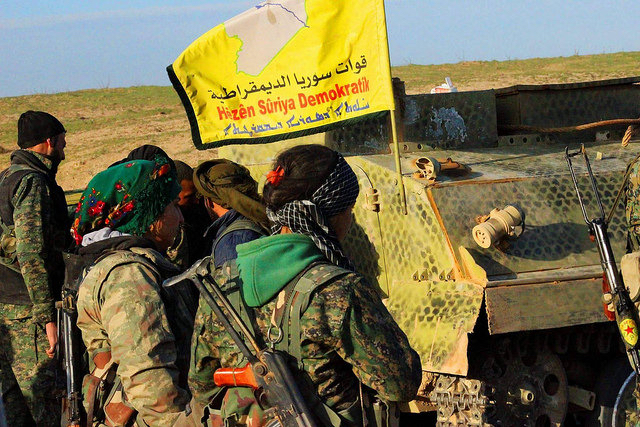Following the Syrian Day of Rage, on March 15th, 2011, the city of Daraa quickly became the strongest flashpoint. By March 18th, thousands of protesters were roaring across Daraa, leading to a brutal suppression by security forces. When resistance continued into late April, Assad directed thousands of troops to lay siege of the city. This was one of many escalations that led to the Syrian civil war. Importantly, it occurred in a city that partially revolted because it has been devastated by climate change.
What caused the Arab Spring? There are multiple answers, including corruption, unemployment, and food insecurity. There has been a slew of recent studies that points to climate change as yet another factor. This isn’t because climate change is a game changer. Rather, climate change intensifies situations that are already unstable, which results in disaster. Its effect on the Syrian civil war is a perfect case study, especially in its ultimate empowerment of jihadist groups.
Early this month, the US Department of Defence made headlines with a report that actually just updated positions it originally expressed in 2004. One is that the effects of climate change will ultimately fuel “extremist ideologies and conditions that foster terrorism.” It is unclear about specifics, but such a claim is also extremely difficult to measure. After all, as Chuck Hagel states in the foreword, climate change does not produce new and particularly unique challenges. Instead, it is a “’threat multiplier,’ because it has the potential to exacerbate many of the challenges we are dealing with today, from infectious disease to terrorism.”
“Threat multiplier” is becoming a relatively common term in diplomatic circles when discussing the political effects of climate change. It basically means that rather than jolting new conflicts, global warming simply kicks the ones we have into overdrive. It does this by acting as a far-reaching agent of instability, as the DOD report argues on page 7:
“The impacts of climate change may cause instability in other countries by impairing access to food and water, damaging infrastructure, spreading disease, uprooting and displacing large numbers of people, compelling mass migration, interrupting commercial activity. These developments could undermine already-fragile governments that are unable to respond effectively or challenge currently-stable governments, as well as increasing competition and tension between countries vying for limited resources.”
The predicted endgame is what is most worrying: “These gaps in governance can create an avenue for extremist ideologies and conditions that foster terrorism.” This clearly is what ended up happening.

This wasn’t inevitable. It is true that climate change undermined the “already-fragile government” of Assad, which led to civil war. One of the primary reasons that Syria imploded, despite initially being seen as relatively stable, has everything to do with global warming. Assad was already reeling from water scarcity and droughts. From 2006 to 2011, Syria suffered the worst long-term drought, and most severe crop failures, in recorded history. 75% of farmers suffered total crop failure, and in the northeast, farmers lost 80% of their livestock. As a result, 1.5 million people were internally displaced. Most ended up migrating to urban areas that were already crowded, and having difficulty managing Palestinian and Iraqi refugees. Add in the fact that Syria’s neighbors are siphoning its water resources; the price of wheat doubled from 2010 to 2011 due to extreme weather events, instability in the oil market, and heavy speculation; and that the country has been facing an extended pattern of winter drying since 1973, and you have a powder keg.
Does this mean that climate change effects like droughts threaten all governments with collapse? It is too soon to say. The answer appears to depend on whether they are risking collapse anyway. After all, Turkey has also been affected by drought in recent years, the same as the United States, and neither face anywhere near the same level of instability. They had widespread frustration with water scarcity in the same way as Syria, but they didn’t experience the same result, because the political context was different. Assad was facing a revolution anyway. Global warming only made it worse for him, since the five-year drought showcased the Ba’ath Party’s immense shortcomings in mismanaging land, food, and water resources. It is no coincidence that Daraa is a major center of rage against Assad, and also a part of the agricultural heartland.
What requires more support is the idea that jihadist groups are always going to thrive in such desperate conditions. The DOD is careful when it talks about this. It says, “these gaps in governance can create an avenue for extremist ideologies and conditions that foster terrorism.” “Can” is the operative word. Since climate change has political effects that depend on social and historical context, it is fair to argue that the ideological impact runs on similar terrain. The disenchanting forces of market-driven society lead people to seek transcendence, and create alternative social structures, which can be manifest in just about anything. For decades, there has been a contest about just what that alternative force will be: pan-Arabism? Anarchism? Salafism? Jihadism? And so on.
It appears that the fundamentalists have won this contest in the short-term fallout of the Arab Spring. As a result, it is fair to say that global warming helped Syrian jihadism, because it multiplied the conditions that led to groups like ISIS prospering. That wasn’t inevitable, though. Extreme weather events like those which climate change brings about have allowed non-jihadists to win before too, such as the Bhola Cyclone of 1970, which killed 300 000 people in present-day Bangladesh. The storm ultimately multiplied the appeal and success of Bangladeshi nationalism, because the effects it generated (in the anemic West Pakistani relief effort) illuminated the various social problems that seemed to make independence necessary in the first place. The exact ideology and platform is interchangeable.
Ultimately, the question of whether or not climate change fuels terrorism may be one of whether or not there was existing instability that would have empowered terrorism anyway. Global warming doesn’t necessarily birth new processes of violence and decline. It speeds existing ones along by making the various pressures on them more severe. This isn’t just occurring in Syria, of course. It is a common story all over the region. For instance, although climate change didn’t cause Iraq’s Maliki government to implode, and cede massive amounts of territory to ISIS, it did make things substantially more difficult. (Especially when ISIS started weaponizing Iraq’s dwindling water reserves.) The same goes with water shortages in Yemen. Existing dynamics were worsened, and processes already in motion used global warming as a catalyst to reach conclusions that were already inevitable.
As a result, there is a great deal of uncertainty about what comes next. The post-Cold War period lacks an alternative to market-driven society as it actually exists, and it could very well be the case that by massively accentuating the present pressures on the global socioeconomic order, such as terrorism and migration, climate change will end up quickening its dissolution in favor of a new democratic consensus. It could also be true that it sanctions new forms of violence to protect the status quo, especially when it comes to policing borders and safeguarding current levels of water consumption. We will have to see what happens.
Photographs courtesy of Freedom House and Evgeni Zotov. Published under a Creative Commons License.





